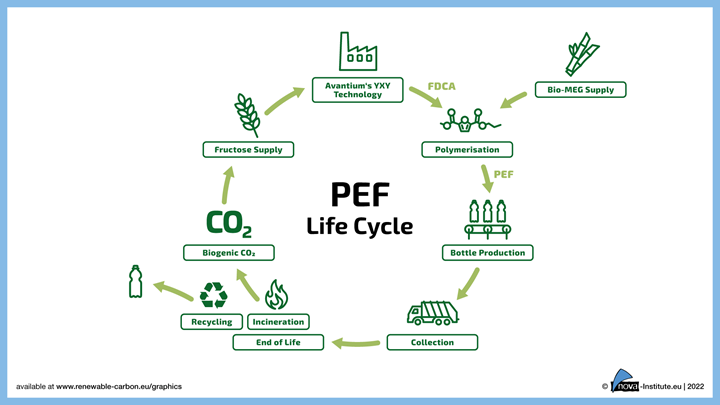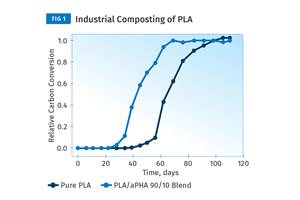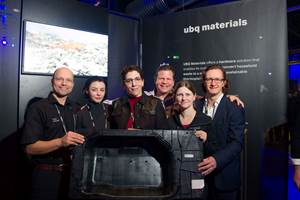Biobased PEF Shows Low CO2 Footprint
Peer-reviewed study by nova-Institute of Avantium’s PEF would result in significant reductions in greenhouse gas emissions.

Within the last couple of years, we have reported on the progress made by Amsterdam-based technology company in renewable chemistry Avantium with its plant -based PEF (polyethylene furanoate). This year alone, we reported on the company’s plans to start-up the world’s first commercial FDCA (2,5-furandicarboxylic acid), the main building block of PEF, in 2024. We also reported that the company has signed offtake agreements with both the global brewery group Carlsburg and the Brazilian brewing company AmBev for the securing of fixed volumes of PEF produced by the new plant.
More recently, the nova-Institute conducted a peer-reviewed Life Cycle Assessment (LCA) of PEF applications within the framework of the European PEFerence project. The study demonstrated that the use of 100 % renewable carbon in PEF instead of fossil carbon in PET for producing 250 ml and 500 ml bottles would result in significant reductions in greenhouse gas (GHG) emissions. Plant-based carbon has a net-neutral impact on the CO2 concentration in the atmosphere. In contrast to this, materials and polymers based on fossil carbon from underground, release additional CO2 into the atmosphere.

Avantium’s YXY technology converts plant-based sugars into a fully recyclable polymer. The new 100 % bio-based polymer, PEF has been shown to have superior performance properties compared to PET. Its main building block FDCA can be produced from sugars (fructose), for example from wheat, corn and sugar beet. FDCA is polymerized with plant-based MEG (mono-ethylene glycol) to make a 100 % plant-based PEF polymer. When fully technologically developed, PEF can also be produced from cellulose and thus from agricultural and forestry waste streams. Avantium’s current process utilizes starch from European wheat.
PEF has enhanced barrier properties compared to PET, it is mechanically and chemically recyclable and can also be recycled within the established PET recycling. PEF has a 53.6 F/12 C higher heat resistance than PET, a 60 % higher modulus and greater strength than PET. This allows the developing of lightweight packaging from PEF with lower resource requirements. Avantium has already implemented this innovative, plant-based packaging material on a pilot scale and recently started the construction of a 11 million lb/yr FDCA flagship plant in Delfzijl (the Netherlands). The nova-Institute’s peer-reviewed full cradle-to-grave LCA conducted according to the ISO standards 14040/44 indicates a significant reduction potential in greenhouse gas emissions and use of fossil resources of PEF compared to PET.
A critical peer-review of the study, including experts of LCA methodology and incumbent packaging solutions, verified that the LCA met the requirements for methodology, data, interpretation, and reporting. The LCA evaluated 16 different impact categories covering all relevant life cycle stages from cradle-to-grave. The comparative analysis showed that PEF bottles would result in significant Institute for Ecology and Innovation 2 reductions in greenhouse gas emissions (-33 %) compared to reference PET bottles. PEF would also lead to 45% lower finite resource consumption of fossil fuels and reduce the pressure on abiotic resources (minerals and metals) by 47 % due to the mechanical properties of PEF enabling light-weighting.

However, PET bottles would outperform PEF-bottles in other impact categories mostly arising from the current feedstock supply. Overall, this represents a benefit because climate change and resource use are among the most relevant environmental impact categories in the current political agenda. They are driving the transition from fossil to renewable carbon. In addition to monolayer PEF bottles, PEF can also be used for multilayer packaging. Multilayer bottles can be an option when the required shelf life cannot be guaranteed by monolayer packaging. PEF offers a good passive barrier for O2 and CO2 and could potentially contribute towards reducing the environmental footprint of packaging solutions by increasing the shelf life of products, enabling a reduction in the weight of packaging, and by improving recyclability.
In this LCA, 250 ml PET/PEF multilayer bottles with 10% of PEF were also assessed and compared to reference PET/PA bottles with a typical 7% of PA (nylon). The analysis showed that significant reductions of around 37% in GHG emissions could be achieved by replacing the PA layer with PEF, mainly attributed to the recyclability of the PET/PEF system over the non-recyclability of the PA-containing system. This replacement would also contribute to a significant reduction of finite resources demand (-37% and -52% of fossil fuels and minerals and metals, respectively).
It is expected that the commercialization and growth of the PEF market will lead to substantial economic, technological, and environmental optimizations covering the full value chain. The impact originating from the plant-based feedstock could also be further reduced by a switch to lignocellulosic feedstocks such as second-generation biomass. This will be tested at Avantium Renewable Polymers in the framework of the BBI-JU PEFerence project, and should confirm that the YXY process can use second-generation biomass when it becomes available at commercial volumes and pricing. An update of the LCA is planned afterwards. A more detailed report on the LCA is available at www.renewable-carbon.eu/publications.
Related Content
Blend Amorphous PHA with PLA to Improve injection Molded Part Properties
Adding aPHA to PLA can boost a range of mechanical properties and expedite composting. Here are the details as well as processing guidelines for injection molding the blends.
Read MoreHonda Now Exploring UBQ’s Biobased Material Made from Unsorted Household Waste
UBQ is aiming to expand its reach for more sustainable automotive parts as well as non-automotive applications.
Read MorePHA Compound Molded into “World’s First” Biodegradable Bottle Closures
Beyond Plastic and partners have created a certified biodegradable PHA compound that can be injection molded into 38-mm closures in a sub 6-second cycle from a multicavity hot runner tool.
Read MoreBest Practices for Purging PHA and PHA/PLA Blends
Because bioplastics are processed at lower temperatures, purging between jobs requires a different process and purging agents than those applied for traditional resins.
Read MoreRead Next
Lead the Conversation, Change the Conversation
Coverage of single-use plastics can be both misleading and demoralizing. Here are 10 tips for changing the perception of the plastics industry at your company and in your community.
Read MoreMaking the Circular Economy a Reality
Driven by brand owner demands and new worldwide legislation, the entire supply chain is working toward the shift to circularity, with some evidence the circular economy has already begun.
Read More
























